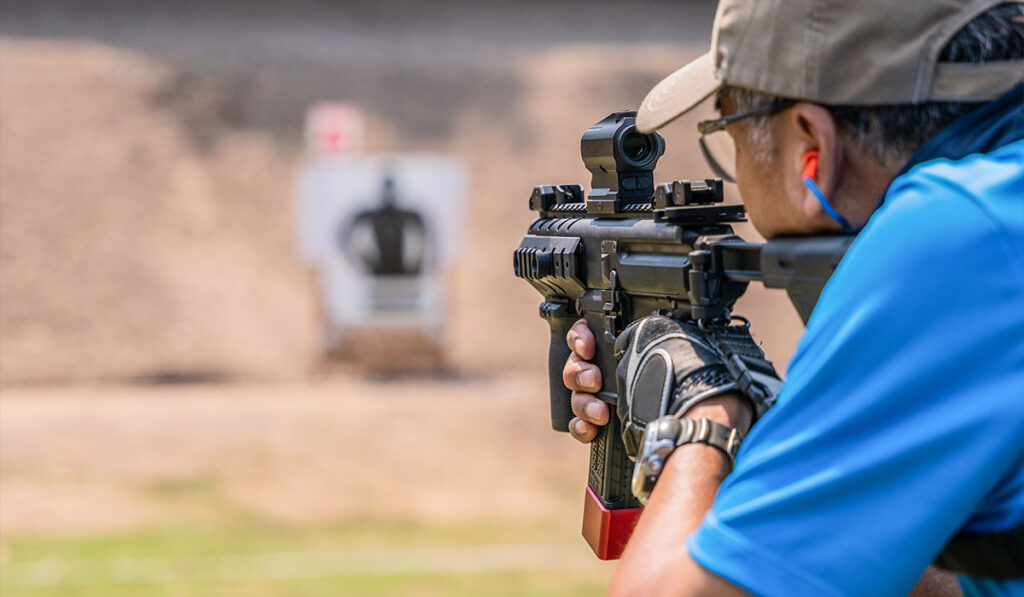Fear….. It is the number one item that everyone forgets to prepare for in cases of survival, emergency situations, and personal protection. Yes, you may have your Get Home Bag, your Bug out Bag, your SHTF location, and your weapon. But did you prepare to deal with FEAR? Most likely NOT.
Unless you can manage fear, you have an exceedingly high probability of not surviving. Fear strikes fast, it sometimes produces uncontrollable responses; it distracts you from what is really going on and significantly inhibits your ability to make the correct decisions.
Acting out of fear can get you into more trouble than the situation you are already in. Fear comes in many forms and levels. The simplest might be fear of insects, spiders, and snakes, more intense fear might be the instilled fear of heights, public speaking, or the unknown, and extreme fear might be the fear of death, injury, or pain.
Preparing Yourself and How You Respond

The most intense form of fear can completely incapacitate a person. Even though each level of fear elicits a primal reaction, each person will have a different response based on their experiences.
To enhance your likelihood of survival or functioning during a bad event, you must learn how to control your fear. It is not easy and requires significant training and practice to master the process.
But it should be equally as important as any part of your planning process such as packing your Get Home Bag, practicing personal protection shooting, and being physically fit.
As part of evolution, the human brain has developed a very sophisticated means of dealing with fear to enable us to survive. In most cases, fear is primal in function and activates our bodies to take the “fight or flight” posture and response.
Sixth Sense
There are many respected people, such as myself, that believe “premonition” is also a fear response. That your body can feel or anticipate something bad, thus making you feel uncomfortable and having the desire to feel like you need to be on alert.
Whether real or perceived, in each of these cases, your body is responding to what it perceives as a threat and your fear response has been activated.
When something instantly scares you, it is easy to have a primordial response and overreact, respond quickly without thinking and immediately go into a defensive mode. Anyone one of these three primal responses could save your life. On the other hand, any one of these three responses could injure or kill you too.
Some of the devastating effects of fear are hesitation, confusion, and chaos. When those are the first responses to a fearful event, you are at a disadvantage. Even worst these factors can interfere with your ability to analyze the situation, thus it will take longer than normal to regain your thoughts, situational awareness, and figure out what is happening.
In the interim, you or someone else may become a victim of the circumstance because of your delay in properly responding to the threat.
Your Brain and Fear

Let’s explore how fear is managed by the body. In general, fear is managed and dealt with totally in the brain. Several key parts of the brain deal with fear and activate the body’s various responses.
One part of your brain, the amygdala, sends out the signals for an immediate response, while the frontal cortex of the brain is trying to determine what is happening and analyze the response.
To overcome inappropriate responses to a fearful event and increase the speed in which you correctly respond. You must learn how to control and sometimes override some of these cerebral functions.
The brain takes two kinds of actions when confronted with fear. The amygdala reacts fast and initiates the primal response of fight or flight.
The frontal cortex follows with questions such as “what just happened?”, “what should I do?”, “what will happen if I do something?” Overcoming the controlling power of the amygdala and rationalizing the questions of the frontal cortex requires considerable training and practice.
To be in control during a fearful event you must learn how to control these two separate parts of the brain. The military completely understands the role fear plays in being able to perform your assigned functions during a scary and stressful event.
So they go to great lengths to determine one’s ability to manage fear. One of the biggest fears of a human being is the inability to breathe. If you have ever choked on anything, you know the experience. You freak out and you go into panic mode immediately.
Based on that fear, during BUDS (Basic Underwater Demolition School) the Navy Seal program conducts several drills to test the students’ ability to manage fear. Several of these tests are conducted underwater in very stressful conditions.
One such test requires the recruits to bob from the bottom of the pool to the top of the pool while their hands and feet are bound. Thus, they need to rise to the top of the pool take a quick deep breath, then slowly sink to the bottom of the pool while holding their breath and keeping their body under control. Then once at the bottom of the pool use their legs to propel them upward toward the top to take another breath.
In another drill, the recruits kneel at the bottom of the pool with all their dive gear in place, masks, tanks and fins. Then instructors swim to the recruit and pull all their equipment off, turn off their tanks, tangle up their equipment, and rough house the student.
After a predetermined amount of time, they leave the student and the student must untangle the equipment, turn on the tanks, and put all the equipment back on.
These are incredibly stressful and fear-inducing events. Thus, surviving these events and demonstrating you can control your fear, plays a significant role in moving to the next stage of the SEAL training program.
If you cannot control your fear in these situations it is highly unlikely you will not be able to do so in far more complex and uncontrolled environments.
Now, what the SEAL program does is an extreme method of training. It is not something you should try. But if you do not practice at your respective level, then when a fearful experience occurs to you, you will most likely not be able to deal with the situation in a timely and effective manner.
So how do you prepare to address fear and make sure that it does not interfere with your ability to address an adverse event? I recommend six ways to prepare yourself for a fearful event. The scope of this article is going to focus on managing fear in a personal protection or survival situation. You can use the same tools to combat other types of fear.
Training

Training is the most important aspect of dealing with fear. If you do not obtain good training, then you will not know the correct technique to use in dealing with a fearful situation and your self-confidence will be compromised.
One of the key factors in dealing with fear is having the confidence that you can overcome the fear and deal with the situation. Knowledge decreases fear by increasing your ability to understand a situation and address it.
So whether it is a survival course, a firearms course, or a self-defense course you need to take training. One key tip about training courses is that you must choose good ones. There are lots of training programs, in particular firearms courses, that are taught by individuals that do not have the experience or expertise to teach these courses.
No matter what course you take, be sure to ask about the instructor’s qualifications and experience. So your valuable money and time are put to good use and you GET something out of the course.
Practice
Once you have received training you must practice, practice, and practice. Muscle memory and mental memory are two key factors in the immediate response to a fearful situation. Muscle memory and mental memory are very similar.
They are responses that are preprogrammed into your muscles and brain as the result of repetitive training. You have practiced them so many times that your response requires little to no thought.
Practicing enables you to control the primal response generated by the amygdala and perform a well-practiced action with limited interference from the amygdala. This is where muscle and mental memory come into play and become major assets.
The practice also plays a major role in helping you control the frontal cortex, the part of the brain that is going to question your actions. For example, “What if they think I am the bad guy?” “What if I get beat up?” ” What if I get hurt?”
Practicing helps you override those questions because you know what you are going to do, you have practiced it, and you are confident in your ability to do what needs to be done, eliminating any hesitation in your response to the bad situation.
The next four tools that help you manage and deal with fear are used by Navy SEALS. Naturally, there are other methods, but the SEALS have gone to great lengths to understand the fear and develop techniques to manage it.
Goal Setting

One of the main keys to survival and dealing with a fearful situation is to remain focused. This means you must control the frontal cortex of your brain, which is going to question everything you do and constantly keep coming up with other ideas.
So to survive and succeed you must focus your full attention on the situation at hand. For example, if it is an instant event such as a robbery then you must immediately focus on personal protection, subduing the adversary, and getting to safety.
If it is a survival situation, it might mean you must focus on finding shelter, starting a fire, or to get your bearings. By creating short-term goals for yourself, you keep your mind busy and occupied with tasks that are essential to the immediate time frame and self-preservation.
Thus, keeping you from getting distracted with thoughts that might induce greater fear and resulting in you becoming unfocused and distracted, causing you to fail.
Mental Rehearsal
Mental Rehearsal and visualization are one and the same. They both involve the same techniques and they both are invaluable in preparing to deal with a fearful event. Both require a tremendous amount of mental focus and preparedness.
This technique requires you to think through any scary event you may encounter and prepare yourself mentally for dealing with the situation. This requires you to really focus on the task at hand and consider all the options that might occur as part of completing the tasks. Equally important you want to see yourself finishing the tasks.
You cannot do this just once and think you got it. You need to practice this very frequently to master it. For example, you may be scared of elevators, as I am, but you know you have a meeting on the 19th floor and it is a glass elevator.
So you first think through the process as no big deal, I can handle this. Then you plan your ride. I am going to get in, stand near the door and not look at the panel indicating the floors as we go up.
I will do my best to have a conversation while going up and focus on the person I am talking to. When doors open I will be polite and let everyone else out first. You should think about this event several times and in each case consider different things that might happen.
Such as, what if I am in the elevator alone? What if their person in the elevator does not want to talk? What if the elevator stops on a floor before mine? By using this technique you keep your mind focused, instill confidence in yourself and you create a sense of I have done this before and you have a plan of action.
Self Talk
This is a powerful tool. As you read earlier in this article maintaining focus is essential to survival and dealing with fear. This is a constant task; keep your frontal cortex from going wild with thoughts, so you can maintain your focus.
Self-talk is a tool you can use, before a fearful event, during it, and after it. Here are examples of each situation. In the time before an event can use self-talk to increase your confidence, see your way through the event, and mentally prepare for the event.
For example, you have to walk down a dark alleyway that you know is in a high-crime area. So you start by saying, I know I can do this. All I need to do is stay focused and be prepared. If this happens I am going to do this. This is easy; I am just going to watch all around me as I walk.
During the event, you may use self-talk to prepare for your next move. Such as, if confronted you may think to yourself, if he does this I am going to do that. During a longer survival type situation, you might talk to yourself and decide what you need to do, describe the positive aspects of your situation, and assure yourself you can do this.
Recently, there was an episode of Naked and Afraid that featured two participants that were placed in the jungle. The male was an experienced veteran with multiple combat deployments and a retired police officer.
The female was a single mom who was a baker with little survival experience. In the early going of the event, the male survivalist was very critical of some of the female’s skills and touted how strong and experienced he was.
Yet within two days he tapped out and left her alone. For the next several days as she endured many, many obstacles, she keep saying to herself, I can do this, I must do this for my daughter, and I am not giving up. She made it the whole 21 days, an incredible and powerful testament to her determination, commitment, and use of self-talk.
Once an event is over you still must use self-talk as a tool to maintain your focus. What is known as “condition black” means your brain may be working very hard to analyze what just happened and this creates tremendous chaos in your mind.
The ability to self-talk yourself and assure yourself that everything is ok and to calm down and do what needs to be done next, plays a vital role in keeping your head after an event.
Arousal Control
Arousal control is paramount to dealing with fear. There are two instances where arousal control is necessary and needs to be implanted to control your body and mind. The first comes while you are getting ready for or anticipating a scary or fearful event.
In this case your body will become anxious as the amygdala releases its power to get your body ready for a fight of flight. During this time you may have a hard time concentrating, you will be distracted by negative thoughts and you will feel yourself getting nervous.
This is the time you should be visualizing your upcoming experience and getting mentally ready for the adventure. But you can’t because you are scared and nervous.
In the second case, the instant a fearful stimulus is received the amygdala goes into action. Instantaneously your body reacts. Immediately you take a defensive posture and action. Your brain and body have reacted before you even knew why?
In both cases, arousal control is imperative to keep your mind and body under control. One of the best means to control arousal is deep breathing. Box breathing is taught in the special forces community to control arousal.
Taking slow deep breaths as you count to 4 and then slowly exhaling as you again count to 4 lowers your heart rate and blood pressure, reduces the release of hormones into your body, and adds oxygen to your system. Concentration on this maneuver decreases your body’s desire to release hormones that cause excitement.
Fear is the unknown factor in all fearful, stressful and dangerous situations. The responses to fear can be instantaneous like when you are unexpectedly scared. Or long term as in a survival situation. You never know when the ugly head of fear is going to arise.
In both of these cases, the use of these six techniques can help you overcome fear, respond appropriately and increase the likelihood you will survive. As mentioned in the first part of this article you must practice these skills routinely or when you need them you will not know how to use them and thus they are useless.
As with all personal protection and survival techniques you must be trained, then practice, practice and practice.
Hopefully learning and practicing these skills will enable you to manage fear the next time you are in a fearful, scary or dangerous situation.



